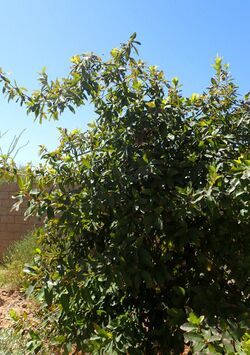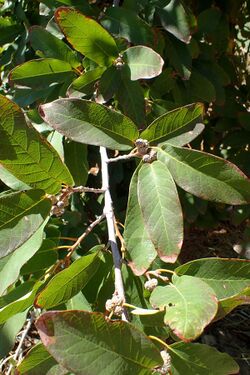Biology:Quercus polymorpha
| Quercus polymorpha | |
|---|---|

| |

| |
| Scientific classification | |
| Kingdom: | Plantae |
| Clade: | Tracheophytes |
| Clade: | Angiosperms |
| Clade: | Eudicots |
| Clade: | Rosids |
| Order: | Fagales |
| Family: | Fagaceae |
| Genus: | Quercus |
| Subgenus: | Quercus subg. Quercus |
| Section: | Quercus sect. Quercus |
| Species: | Q. polymorpha
|
| Binomial name | |
| Quercus polymorpha Schlecht. & Cham.
| |
| Synonyms[2] | |
| |
Quercus polymorpha, the Mexican white oak, Monterrey oak or netleaf white oak, is a North American species of oak. It is widespread in Mexico, Guatemala, and Honduras, and known from a single population in the United States (about 30 kilometres or 19 miles north of the Río Grande in Val Verde County, Texas) but widely planted as an ornamental.[3][4][5][6][7]
Description
Quercus polymorpha is a subevergreen tree up to 20 meters (67 feet) tall. The bark is gray or brown. The leaves are elliptical or egg-shaped, up to 15 centimetres (6 inches) long, unlobed or with a few shallow rounded lobes.[3]
Range and habitat
Quercus polymorpha ranges across eastern and southern Mexico, in the Sierra Madre Oriental and Sierra Madre de Oaxaca ranges, the Chiapas Highlands of southeastern Mexico, and scattered locations on the Mexican Plateau, Trans-Mexican Volcanic Belt, and Sierra Madre Occidental. It is found in the states of Nuevo León, Tamaulipas, San Luis Potosí, Querétaro, Hidalgo, Veracruz, Puebla, Oaxaca, Chiapas, Coahuila, Guanajuato, Jalisco, Sinaloa, Michoacán, and Morelos. There is a single population in Val Verde County of southern Texas. There are scattered populations in the Guatemalan Highlands of central Guatemala, including Chiquimula, Huehuetenango, Jalapa, and Zacapa, and in western Honduras.[1]
The species grows in a variety of habitats, including deep canyons in the Sierra Madre Oriental, riparian gallery forests, the margins of thorn scrub forest, tropical dry forests, the lower margins of montane oak–pine forests, and cloud forests. It is found from 400 to 2,100 meters elevation.[1]
References
- ↑ 1.0 1.1 1.2 Jerome, D. (2017). "Quercus polymorpha". IUCN Red List of Threatened Species 2017: e.T194221A2304665. doi:10.2305/IUCN.UK.2017-2.RLTS.T194221A2304665.en. https://www.iucnredlist.org/species/194221/2304665. Retrieved 28 September 2022.
- ↑ "Quercus polymorpha Schltdl. & Cham.". World Checklist of Selected Plant Families (WCSP). Royal Botanic Gardens (Kew). http://www.theplantlist.org/tpl1.1/record/kew-174496.
- ↑ 3.0 3.1 Nixon, Kevin C. (1997), "Quercus polymorpha", in Flora of North America Editorial Committee, Flora of North America North of Mexico (FNA), 3, New York and Oxford, http://www.efloras.org/florataxon.aspx?flora_id=1&taxon_id=233501074
- ↑ "Quercus polymorpha", County-level distribution map from the North American Plant Atlas (NAPA) (Biota of North America Program (BONAP)), 2014, http://bonap.net/MapGallery/County/Quercus%20polymorpha.png
- ↑ Muller, C. H. 1942. The Central American species of Quercus. United States Department of Agriculture. Bureau of Plant Industry. Miscellaneous Publication 477: 1–216
- ↑ Breedlove, D.E. 1986. Flora de Chiapas. Listados Florísticos de México 4: i–v, 1–246.
- ↑ Texas A&M Forest Service, Trees of Texas
External links
- photo of herbarium specimen collected in Nuevo León in 1991
- Beat Springs Blossom, Nature Education includes photos
- Native Plant Database profile, Lady Bird Johnson Wildflower Center, University of Texas at Austin: includes photos
Wikidata ☰ Q4112232 entry
 |


